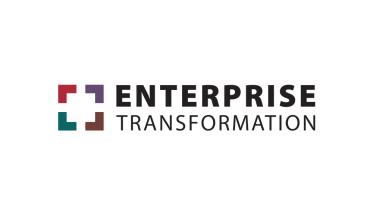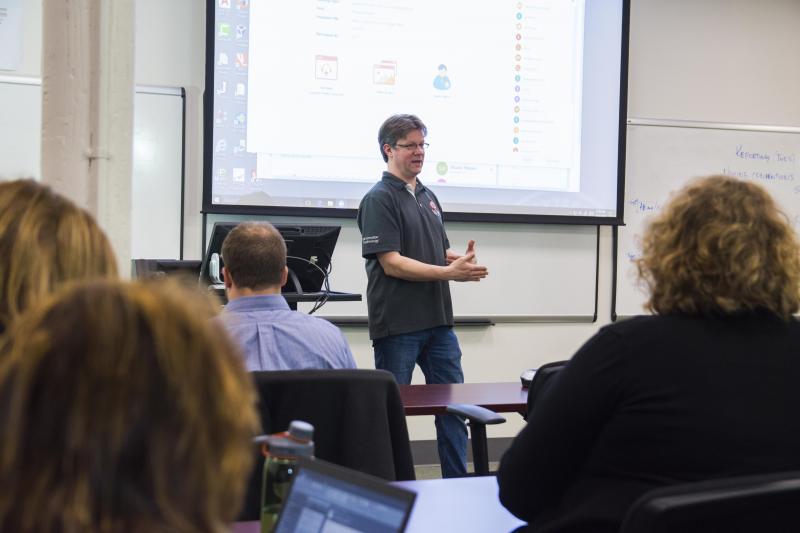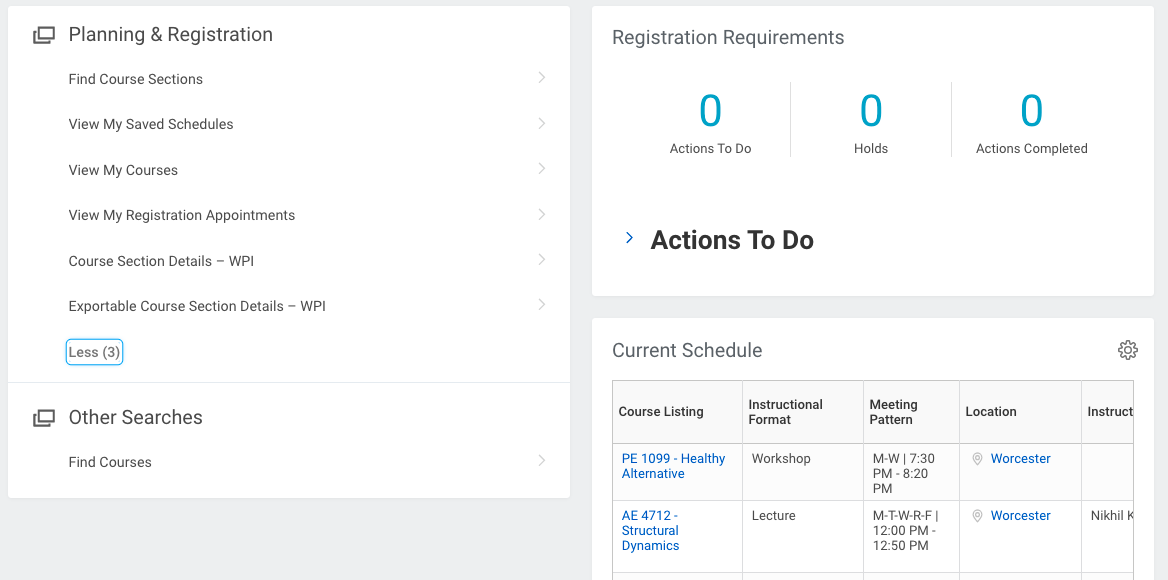
Enterprise Transformation Automates Processes and Elevates WPI (Part 1 of 4)
First Phase: Replacing Banner
- Challenge: Consolidating human resources, finance, and billing information in an easy-to-use, automated, mobile-friendly system
- Solution: Implementing Workday systems
- Timing: Launches October 2018
Offices and Departments
Enterprise Transformation
Enterprise Transformation is WPI's significant update of the existing technology infrastructure on campus. Once implemented, the project will dramatically improve processes and procedures across the university.
This initiative will roll out over the next four years and touch every person on campus. Enterprise Transformation will improve the user experience for faculty, staff, and students while also providing the university with the cutting-edge security standards necessary at such a competitive, research-focused institution.
Enterprise Transformation is WPI’s latest project to improve and advance university processes and infrastructure, and when this four-year project is complete, the restructuring process will have touched just about every person on campus.
With the implementation of the project, areas like finance, human resources, student projects, billing, grading, data quality and control, and analytics will be consolidated and improved. “This project will help WPI streamline processes and move to more user-friendly, scalable, cloud based architecture,” says Patty Patria, Vice President for Information Technology and CIO. A web presence for Enterprise Transformation offers additional information and updates about the project.
The first and most extensive change is the transition from Banner to Workday, which is set to launch in October 2018 for human resources and finance functions. The planned launch is the beginning for the new phase, but it is also the culmination of lengthy, highly detailed work. Groups have been meeting for collaboration sessions to help shape the architecture and the design of the Workday building process to customize it to WPI’s needs.
Innovator of super-sonic aircraft design
As an engineer at NASA's Langley Research Center, Dr. Richard T. Whitcomb solved a problem that had stood in the way of practical faster-than-sound flight. In 1952, he discovered and later experimentally verified a revolutionary aircraft design concept called the Transonic Area Rule. The rule greatly cut drag at near-sonic speeds by making local reductions in a plane's cross-sectional area. In the late 1960s, he invented the Supercritical Wing. With its unconventional shape-nearly flat on top, and downward sloping near the trailing edge-it enabled many airliners and business jets to either fly close to the speed of sound or realize substantial fuel savings. The Area Rule and the Supercritical Wing have influenced the design of most new aircraft built in the last half century, and both are considered major contributions in advancing the critical goal of maximizing fuel efficiency while improving performance and safety in all aircraft.
Whitcomb's extraordinary contributions to aviation have resulted in numerous awards and honors, including an honorary doctorate from WPI; the National Medal of Science (presented by President Richard Nixon in 1973); the NASA Scientific Achievement Medal, and the Collier Trophy, aviation's highest honor. In 2003, he was inducted into the National Inventors Hall of Fame for his development of the supercritical wing.
For his visionary contributions to society, engineering, science and flight, WPI is proud to present the WPI Presidential Medal to Richard Whitcomb.
Presented June 5, 2003, at the Presidential Advisory Council Dinner as part of WPI's celebration of the 100th anniversary of powered flight.
WPI has used Banner for nearly three decades as a system to track employees’ human resources and finance information and student billing, grading, and admissions. After being notified that the current version would no longer be supported by Banner, WPI decided to explore other products. Workday’s product is used by many other top universities like Bentley, Cornell, and The Ohio State University because it offers the basic tools and structure universities rely on to operate smoothly, but it’s also known for being user-friendly.
Unlike the often-cumbersome Banner, Workday’s implementation will allow students, faculty, and staff to access information easily, quickly, and even from mobile devices through Workday mobile apps. “There are numerous self-service features that will help people find the information they need,” says Sia Najafi. “The more we automate it, the more it enables end users and gives accurate decision making with data makers.”
Implementing Workday
The official transition will happen in October 2018 and will involve processes related to benefits, talent management, payroll time tracking, compensation, workforce planning, recruitment, and financial management tools like accounting, budgeting, and grants management. As with any major project, the implementation of changes will be iterative and defined based on the process flow, says Daniel Amsden, director of the program management office in Enterprise Information Systems.

Daniel Amsden addresses a group training in Workday techniques.
“This has been a couple of years in the making,” says Amsden. “From the IT perspective, years ago we had raised a concern that we had to do something about Banner. We recognized there was risk in continuing to use the enterprise resources planning (ERP) structure if it was not supported and if we could not maintain it.”
With a consultant’s assistance, WPI chose Workday among several product possibilities as the best one to meet WPI’s needs and also offer the flexibility to adapt to the specific higher ed environment. “With each platform, we had to ask, ‘What do we need to accomplish?’” says Amsden. “We had to find some of the pain points.”
As Amsden says, the departments that typically had the most involvement with Banner, like human resources and finance, are likely going to be the areas that will experience the most change with Workday. As the launch date nears, all employees will have access to training sessions. As those areas had particular reliance on paper processes, they will see the greatest changes as processes become automated or exist in a mostly online environment.
For most employees, the change will be fairly gradual. For example, when looking at a pay stub, users will have a different login screen. Changes to expense reports will be introduced as well. Because the majority of users will access Workday from their mobile devices, the system is built with mobile use in mind first. “The dashboard is very simple,” says Amsden. “It’s mostly icons. But that’s the point, it should be simple. After this, we'll ask why it was ever not this simple.”
Workday’s implementation will bring about not just new processes, but also a change in the way departments like human resources and finance do the day-to-day business of running the institution. “They will have new terminology, new structures,” says Amsden. “Many of the things on paper today won’t be on paper. We are changing processes, so it’s not just changing the system, but making the decision to accept standard processes and practice.”
For Amsden and his team, aligning WPI’s practices into a uniform and effective model helps the university’s internal structure, but also helps it align with the wider global expectations for regulations and consistency. Once Enterprise Transformation is complete, WPI will have standard processes that enable more effective data-driven decision making.
The end result will mean a smoother process—less time related to tracking down forms, verifying correct information from multiple sources, or reentering data. The transformation, says Amsden, is about making people more of the focus and allowing them to concentrate on the things that make WPI so distinctive.
- By Julia Quinn-Szcesuil
What is Enterprise Transformation?
Editor's note: This is the first of a four-part series to help employees understand the four main projects associated with Enterprise Transformation, WPI’s organization-wide implementation of new computer systems. New installments will run on Tuesdays until May 8.





